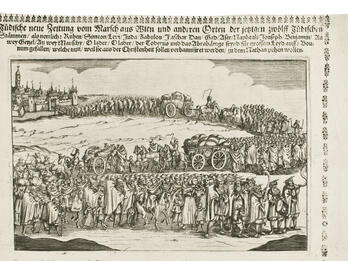The Swedish Siege of Prague
Unknown
1649
During the Battle of Prague (July to November 1648), the last major military clash of the Thirty Years’ War, Swedish forces occupied the city’s castle, which lies on the western bank of the Vltava River, opposite the Jewish quarter. This anonymous Yiddish song, which was published in the year following the battle, depicts the experience of the Jewish community during the battle. It belongs to the genre of Yiddish historical songs that became popular in the early seventeenth century. Such songs, which spread news of events in particular Jewish communities, were printed as inexpensive, popular pamphlets. Their writers were not rabbis or scholars, and they often emphasized the entertainment value of their works. In the introduction to this song, the author describes in gruesome detail an event that occurred on the 10th of Av, when a cannonball fired by the Swedish forces killed nine Jews, providing the victims’ names. The description of the death of the bridegroom, Leib, is supported by a gravestone discovered in the Jewish cemetery in Prague, according to which a man named Leib died a martyr’s death in 1648.
Related Guide
Birth of an Idea: Defining the Early Modern Period
The emergence of the early modern period (1500–1750) in Jewish history is relatively recent and complex.
Related Guide
Early Modern Historical Narratives
The early modern period saw a flourishing of Jewish historical writing in genres ranging from apologetic treatises to chronicles of specific events.
You may also like
Lament over the Jews of Kremzir
Megilat ‘efah (Scroll of Terror)
Yeven metsulah (Abyss of Despair)
Tit ha-yaven (The Miry Clay)



